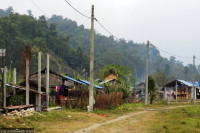National
45 women died during childbirth in six months, in hint of falling deaths
As the number of maternal deaths is low compared to the past, the Health Ministry has not started finding the causes of deaths. Officials cite problems with the reporting system.
Arjun Poudel
At least 45 women died of complications during childbirth since the start of fiscal year 2022-023—possibly the lowest ever maternal deaths recorded in a period of around six months in the country.
Maternal health experts, however, question the authenticity of the data of maternal deaths provided by the Ministry of Health and Population.
“Decline in maternal deaths is very good news, which our country has been struggling to achieve for years,” said Dr Jageshwor Gautam, a maternal health expert. “But the authenticity of the data is questionable. We don’t know if the data on all maternal deaths have been reported or not.”
Nepal had to reduce maternal deaths by 116 per 100,000 births by 2022 to meet one of the Sustainable Development Goals, which the country missed. The country also missed its own 2020 target to reduce maternal mortality to 125 per 100,000 births.
It had reduced the maternal mortality rate from 539 per 100,000 births in 1996 to 239 per 100,000 births in 2016—for which the country even received the Millennium Development Goals award. It is estimated that the number has not declined since then.
The health target under the UN’s Sustainable Development Goals is to reduce maternal mortality rate to 75 for every 100,000 births by 2030.
“Excessive bleeding after childbirth, pre-eclampsia and eclampsia (pregnancy-related high blood pressure disorders) are some of the reasons for the maternal deaths,” said Nisha Joshi, senior public health administrator at the Family Welfare Division under the Department of Health Services. “A lot of pregnant women had died of coronavirus infection during the pandemic. But such deaths have stopped.”
However, Joshi concedes that the concerned health agency has not started reviewing the cause of maternal deaths yet as the officials seem to be complacent due to the low maternal death rate. She also admits that there may have been more maternal deaths during the last six months, as all deaths do not come in the government records. With the decline in coronavirus infection rate, health facilities have stopped reporting maternal deaths.
In the fiscal year 2021-022, 176 maternal deaths were recorded throughout the country.
Every year, on an average over 600,000 women deliver babies.
Health Ministry officials said that several government programmes—increasing antenatal and postnatal care, President’s Women Uplift Programme, free institutional delivery service, and allowances given to pregnant women for antenatal, postnatal and institutional delivery—might have yielded results to reduce maternal deaths rate.
So far, 473 women in labour pain from remote areas of the country have been rescued to advanced hospitals since the start of the President’s Women Uplift Programme some three years ago. The programme covers 48 of the total 77 districts.
Officials say the programme covers all areas of 19 districts and certain local units of 29 other districts.
“In the ongoing fiscal year, we have airlifted 88 women in labour whose health conditions were critical,” said Nita Sharma, an official at the Ministry of Women, Children and Senior Citizen.
Construction of roads in rural settings, posting of medical doctors in remote areas, upgrade of health facilities, and start of caesarean section delivery even in district hospitals, among others, could have contributed positively in reducing maternal deaths, according to them.
A recent report, the Nepal Demographic and Health Survey-2022 carried out by the Ministry of Health and Population, also shows that 94 percent of pregnant women took antenatal care from a skilled provider, 80 percent made more than four antenatal visits and 70 percent received postnatal visits during the first two days after births.
Maternal health experts say that postpartum haemorrhage, pre-eclampsia and eclampsia and infections are among three major causes of maternal deaths.
The World Health Organisation said postpartum haemorrhage is the leading cause of maternal mortality in low-income countries and the primary cause of nearly a quarter of all maternal deaths globally. Most deaths resulting from the said complication occur during the first 24 hours after birth.
The UN health agency said that the majority of these deaths could be avoided through the use of prophylactic uterotonics during the third stage of labour and by timely and appropriate management.
Gynaecologists say tear in the cervix or tissues of the vagina, tear in a blood vessel in the uterus, bleeding in hidden tissue area or space in the pelvis, blood clotting disorders, and placenta problems are among the causes of the postpartum haemorrhage.
“Maternal deaths might have declined visibly but we should not forget that there are still dozens of women dying due to labour-related complications,” said Dr Ganesh Dangal, president of Nepal Society of Obstetricians and Gynaecologists. “Additional efforts should be made to prevent possible deaths.”




 6.12°C Kathmandu
6.12°C Kathmandu










%20(1).jpg&w=300&height=200)



